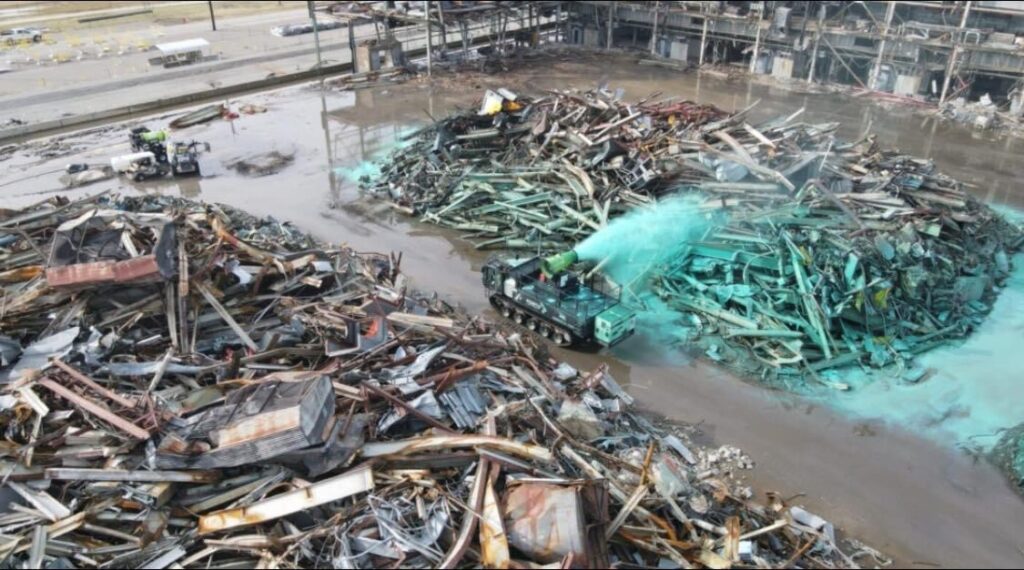JAY SALLEY, NEWS EDITOR – THE SCIOTO VALLEY GUARDIAN
In the previous month, 96 U.S. Senators, cast their votes in favor of an amendment to the 2024 National Defense Authorization Act. The amendment’s aim is to “mandate the Secretary of Energy to establish a Nuclear Fuel Security Program, expand the American Assured Fuel Supply, establish a HALEU for Advanced Nuclear Reactor Demonstration Projects Program, and submit a report on a civil nuclear credit program, and to enhance programs to build workforce capacity to meet critical mission needs of the Department of Energy…”

The current cleanup of the GDP has created a whirlwind of controversies since it began.
In 2019, Zahn’s Corner Middle School closed due to reported contamination within the school building. The Scioto Valley Local School District, at the time, informed the community of the discovery of Neptunium 237 (Np-237), a man-made radioactive element characterized by a 2.144-million-year half-life, in air samples at the school. Np-237 poses significant radioactivity and potential hazards to human health, manifesting in severe repercussions upon ingestion or inhalation, including cancer. The introduction of Np-237 into the environment can occur through the discharge of nuclear waste. Health impacts, experts say, are contingent on the level and mode of exposure, with short-term exposure leading to symptoms like nausea, vomiting, and diarrhea, and prolonged exposure heightening cancer risks. Its presence in the environment is also concerning, as its persistence can lead to contamination of soil, water, and air, along with its accumulation in plants and animals that enter the human food chain.

Private air monitoring stations have reported numerous radioactive isotopes in areas surrounding the plant, extending to Lucasville and Chillicothe.
In April 2019, Dr. Michael Ketterer, Professor Emeritus at Northern Arizona University, released a report following the identification of radioactive contamination within a Lucasville resident’s home. The report concluded that Neptunium and Plutonium found in homes and private air monitoring stations were directly linked to the “Atomic Plant.”
As per the Ohio Department of Health, Pike County’s cancer incidence rate between 2014 and 2018 exceeded the state average by 14% and the national average by 19%. The county predominantly sees cases of Lung and Bronchus cancer, along with elevated rates of Breast Cancer among female residents. A study led by Joseph J. Mangano, MHP, MPA, an epidemiologist and the executive director of the Radiation and Public Health Project, further highlighted that Pike County boasts the highest cancer rates among Ohio’s 88 counties.
In 2020, former plant employees filed a lawsuit against contractors working for the U.S. Department of Energy at the time, alleging the creation of a hazardous environment for workers and nearby residents. The lawsuit, initially branding the contractors involved in “cleaning up the facility” a “criminal enterprise,” was linked to the release of dangerous “isotopes” and “radioactive material” over the years. An additional federal lawsuit was filed against Centrus and the previous site cleanup contractors alleging similar allegations of radioactive contamination in homes near the plant. That lawsuit is still ongoing in federal courts.
While the facility is viewed as a regional economic cornerstone, supplying numerous jobs, concerns about safety outweigh the financial benefits in the eyes of many community members. Vina Colley, a former employee of the GDP, is among those who have taken a stand against the facility. Colley, who has vocally decried rising cancer rates and linked radioactive contamination to the GDP clean-up efforts, appeals for a thorough examination of reports and facts before advocating for full-time operations at the neighboring Centrus facility. She calls upon current Secretary of Energy Jennifer Granholm to take action and to listen to those affected by the radioactive contamination.
Activist groups in the state continue to push for Ohioans, particularly those affected by the Portsmouth Gaseous Diffusion plant, to receive compensation under RECA due to potential radiation-related health concerns. The Radiation Exposure Compensation Act (“RECA”), established under 42 U.S.C. § 2210 note, offers compensation to individuals who suffered serious illnesses due to presumed radiation exposure during atmospheric nuclear tests or uranium industry work. Administered by the Attorney General, the program provides lump sum awards for three groups: Uranium Miners, Millers, and Ore Transporters; “Onsite Participants” in nuclear tests; and individuals who lived downwind of the Nevada Test Site (“Downwinders”).
The Department of Energy maintains that the new HALEU production is conducted within stringent safety parameters and is isolated from the surrounding environment. “We are committed to the highest standards of safety and security in our operations,” said a Centrus spokesperson. However, the glaring disparity between official assurances and the community’s lived experiences underscores the need for transparent oversight and accountability.

Recent Comments